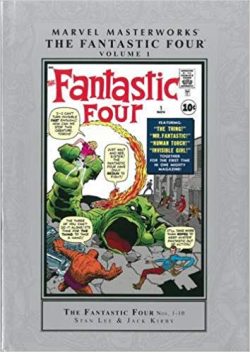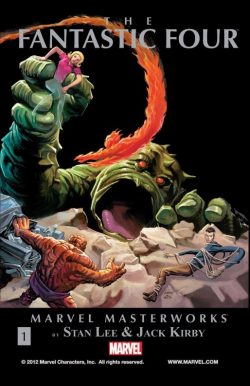

By Stan Lee, Jack Kirby & various (Marvel)
ISBN: 978-0785137108 (TPB 2009)Â Â Â Â Â Â Â Â Â Â Â Â Â 978-0785191292 (HB 2015)
I’m partial to a bit of controversy so I’m going start off by saying that Fantastic Four #1 is the third most important American comicbook of the last 75 years. Just ahead of it are The Brave and the Bold #28, which brought superhero teams back via the creation of the Justice League of America and at the top Showcase #4, which introduced the Flash and therefore the Silver Age. Feel free to disagree…
After a troubled period at DC Comics – National Periodicals as it then was – and a creatively productive but disheartening time on the poisoned chalice of the Sky Masters newspaper strip (see Complete Sky Masters of the Space Force), Jack Kirby settled into his job at the small outfit that used to be the publishing powerhouse Timely/Atlas.
He churned out mystery, monster, romance and western material in a market he suspected to be ultimately doomed but, as always, did the best job possible. That quirky genre fare is now considered some of the best of its kind ever seen.
However, his fertile imagination couldn’t be suppressed for long and when the JLA caught the readership’s attention it gave him and writer/editor Stan Lee an opportunity to change the industry forever.
Depending upon who you believe, a golfing afternoon led publisher/owner Martin Goodman ordering his nephew Stan to try a series about a group of super-characters like the one DC was doing. The resulting team quickly took fans by storm. It wasn’t the powers: they’d all been seen since the beginning of the medium. It wasn’t the costumes: they didn’t have any until the third issue.
It was Kirby’s compelling art and the fact that these characters weren’t anodyne cardboard cut-outs. In a real and a recognizable location – New York City – imperfect, raw-nerved, touchy people banded together out of tragedy, disaster and necessity to face the incredible.
In many ways, The Challengers of the Unknown (Kirby’s prototype partners-in-peril at National/DC) laid all the groundwork for the wonders to come, but the staid, almost hide-bound editorial strictures of National would never have allowed the undiluted energy of the concept to run all-but-unregulated.
Fantastic Four #1 (bi-monthly and cover-dated November 1961, by Lee, Kirby, George Klein & Christopher Rule) is crude: rough, passionate and uncontrolled excitement. Thrill-hungry kids pounced on it.
This full-colour compendium (available in hardback, trade paperback and digital formats) collects the first 10 issues of progressive landmarks – spanning November 1961 to January 1963 – and opens with ‘The Fantastic Four’ exactly as seen in that groundbreaking premier issue.
It sees maverick scientist Reed Richards summon his fiancé Sue Storm, their close friend Ben Grimm and Sue’s teenaged brother before heading off on their first mission. They are all survivors of a private space-shot that went horribly wrong when Cosmic rays penetrated their ship’s inadequate shielding and mutated them all.
Richards’ body became elastic, Sue gained the power to turn invisible, Johnny Storm could turn into living flame and tragic Ben was a hideous freak trapped in a shambling, rocky body.
In ‘The Fantastic Four meet the Mole Man’ they promptly foil a plan by another outcast who controls monsters and enslaves humanoids from far beneath the Earth.
This summation of the admittedly mediocre plot cannot do justice to the engrossing wonder of that breakthrough issue – we really have no awareness today of how different in tone, how shocking it all was.
“Different†doesn’t mean “better†even here, but the FF was like no other comic on the market at the time and buyers responded to it hungrily. The brash experiment continued with another old plot in #2. ‘The Skrulls from Outer Space’ were shape-changing aliens who framed the FF in the eyes of shocked humanity before the genius of Mister Fantastic bluffed them into abandoning their plans for conquering Earth. The issue concluded with a monstrous pin-up of the Thing, proudly touted as the first in a series…
Sure enough, there was a pin-up of the Human Torch in #3, which headlined ‘The Menace of the Miracle Man’ (inked by Sol Brodsky), whose omnipotent powers had a simple secret, but is more notable for the first appearance of their uniforms, and a shocking line-up change, leading directly into the next issue (continued stories were an innovation in themselves) which revived a golden-age great.
‘The Coming of the Sub-Mariner’ reintroduced the all-powerful amphibian Prince of Atlantis, a star of Timely’s Golden Age but one who had been lost for years.
A victim of amnesia, the relic recovers his memory thanks to some rather brusque treatment by the delinquent Torch. Namor then returns to his sub-sea home only to find it destroyed by atomic testing. A monarch without subjects, he swears vengeance on humanity and attacks New York City with a gigantic monster. This saga is when the series truly kicked into high-gear and Reed was the star of the pin-up section…
Until now the creative team – who had been in the business since it began – had been hedging their bets. Despite the innovations of a contemporary superhero experiment their antagonists had relied heavily on the trappings of popular trends in the media – and as reflected in their other titles.
Aliens and especially monsters played a major part in the earlier tales but Fantastic Four #5 took a full-bite out of the Fights n’ Tights apple by introducing the first full-blown super-villain to the budding Marvel Universe.
No, I haven’t forgotten Mole Man: but that tragic little gargoyle, for all his plans of world conquest, wouldn’t truly acquire the persona of a costumed foe until his more refined second appearance in #22.
‘Prisoners of Doctor Doom’ (July 1962, and inked by the subtly slick Joe Sinnott) has it all. An attack by a mysterious enemy from Reed’s past; magic and super-science, lost treasure, time-travel, even pirates. Ha-Haar, me ‘earties!
Sheer magic! And the creators knew they were on to a winner since the deadly Doctor returned the very next issue, teaming with a reluctant Sub-Mariner to attack our heroes as ‘The Deadly Duo!’ (inked by new regular embellisher Dick Ayers).
Alien kidnappers were the motivating force behind another FF frame-up, resulting in the team becoming ‘Prisoners of Kurrgo, Master of Planet X’; a dark, grandiose, cosmic-scaled off-world thriller in #7 (the first monthly issue), whilst a new returning villain and the introduction of a love-interest for the monstrous Thing were the breakthrough high-points in #8’s ‘Prisoners of the Puppet Master!’
The saga was topped off with a Fantastic Four Feature Page explaining how the Torch’s powers work. The next issue offered another, detailing with endearing mock-science ‘How the Human Torch Flies!’
That issue – #9 – trumpeted ‘The End of the Fantastic Four’ as the Sub-Mariner returns to exploit another brilliant innovation in comic storytelling. When had a super-genius superhero ever messed up so much that the team had to declare bankruptcy? When had costumed crimefighters ever had money troubles at all? The eerily prescient solution was to “sell out†and make a blockbuster movie – giving Kirby a rare chance to demonstrate his talent for caricature…
1963 was a pivotal year in the development of Marvel. Lee & Kirby had proved that their new high concept – human heroes with flaws and tempers – had a willing audience. Now they would extend that concept to a new pantheon of heroes. Here is where the second innovation would come to the fore.
Previously, super-heroes were sufficient unto themselves and shared adventures were rare. Here, however, was a universe where characters often tripped over each other, sometimes even fighting each other’s enemies! The creators themselves might turn even up in a Marvel Comic!
Fantastic Four #10 featured ‘The Return of Doctor Doom!’ wherein the arch-villain used Stan & Jack to lure the Richards into a trap where his mind is switched with the bad Doctor’s. The tale was supplemented by a pin-up – at long-last – of ‘Sue Storm, the Glamorous Invisible Girl’…
Although possibly – just, perhaps – a little dated in tone, these are still undeniable classics of comic storytelling illustrated by one of the world’s greatest talents approaching his mature peak. They are fast, frantic fun and a joy to read or re-read. This comprehensive, joyous introduction (or reintroduction) to these characters is a wonderful reminder of just how good comic books can and should be.
© 1961, 1962, 1963, 2009, 2015 Marvel Characters, Inc. All rights reserved.
